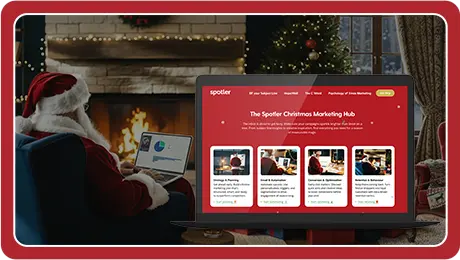Christmas Marketing Hub
Anchor link
An anchor link is a hyperlink that takes users to a specific section on the same web page. Instead of reloading the page, it scrolls directly to the content, saving time and improving the user experience.
Also called a jump link, an anchor link is made using HTML. It connects to a unique ID assigned to a section of the page. Think of a long FAQ page: the list of questions at the top can link users straight to detailed answers below. This makes it easier to find information quickly without endless scrolling.
Whether it’s a long-form landing page, a detailed blog post, or in-depth product documentation, these links help users navigate faster and stay focused. They’re commonly used in menus, call-to-action buttons, or introductory summaries that guide visitors deeper into the content.
For example, developers add an ID to a section (like <div id=”pricing”>), and the link targets it using a hashtag, like href=”#pricing”. Marketers and content creators use this to lead users to what matters, like pricing, feature breakdowns, or sign-up forms, which helps improve engagement and conversions.
Anchor links show up across a variety of marketing touchpoints, such as:
- Landing pages that showcase features and link to pricing or sign-up forms
- Email newsletters that direct readers to specific sections of a web page or article
- Product documentation with links to sections like “setup guide” or “API usage”
- Blog posts with a clickable Table of Contents
- FAQs where each question at the top links to its answer below
Keep expanding your knowledge
The Great British Split Test 2025
Does an all-caps subject line grab attention? Where should you put your CTA for max impact? See what Spotler tested on their own audience.
“Breakup emails”: how to re-engage your coldest subscribers
Every marketer has a segment they avoid looking at too closely: the cold list.
Love at first click: Pre and Post Valentine’s campaigns that deliver real revenue
With the right pre and post Valentine’s campaigns, you can lift revenue, strengthen your data and turn one off shoppers into loyal customers. Join us to find out how!
Events without the Hassle: All the Data, None of the Chaos
Get more out of the events you’re already running. Combine efficiency with a professional experience for your attendees and stop leads slipping through the cracks and follow up with ease.
Become the Brand AI Recommends First. Understanding Citation Authority for 2026
One of the biggest emerging opportunities is citation analysis and citation building for AI platforms. Find out how you can get AI to cite your brand via GEO.
Galentine’s Day: the fastest growing seasonal trend marketers should pay attention to
Galentine’s Day has grown from a small cultural moment into one of February’s most commercially interesting trends.
B2B Valentine’s ideas: campaigns that will not make tour audience cringe
Heart emojis and pink colour palettes are less likely to move your business customers. But there are other ways to make use of Valentine’s Day.
How to use personalisation without making it creepy this Valentine’s Day
Buyers want the personal touch, but they don’t want you too close. How do you get the balance right this Valentines Day?
Love, loyalty and LTV: turning Valentine’s shoppers into year-round customers
How do you turn your Valentine’s shoppers from spring fling to long-term relationship?
7 ways to make emails more interactive in 2026
Inboxes are more competitive than ever; it is estimated that 376.4 billion emails were sent every day in 2025.

